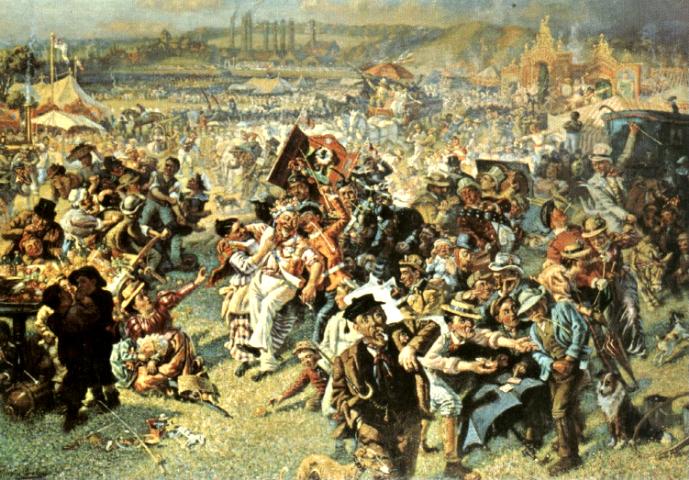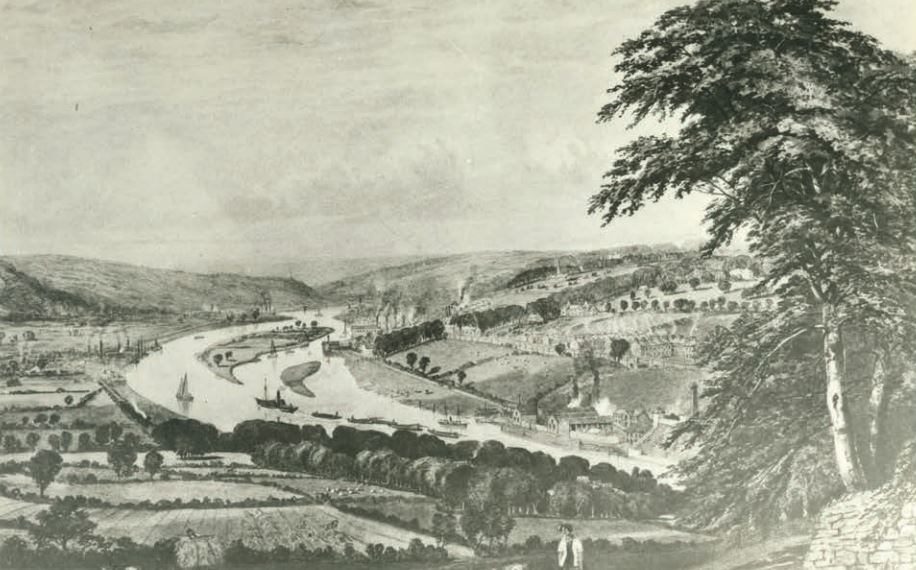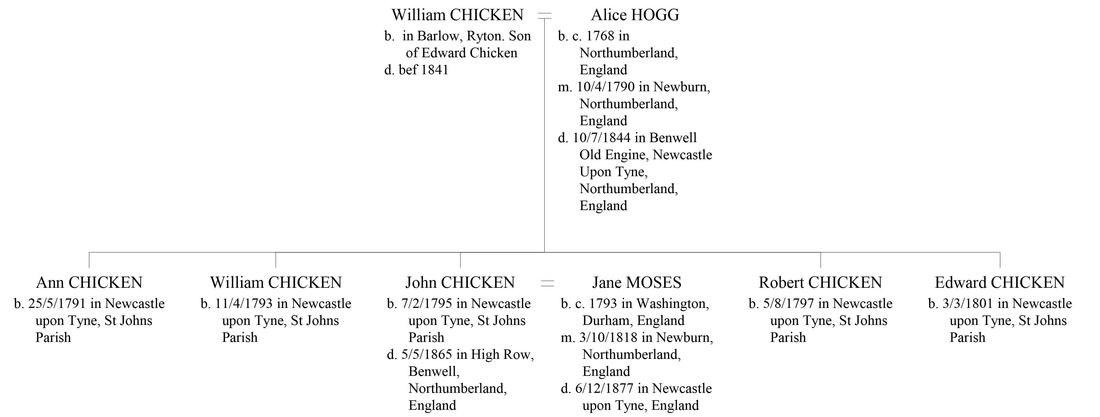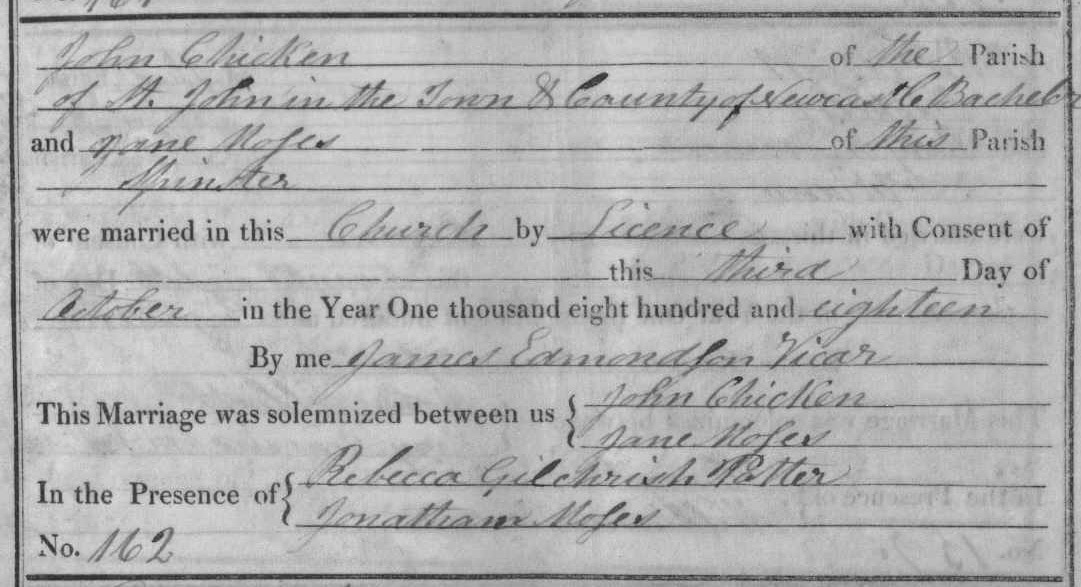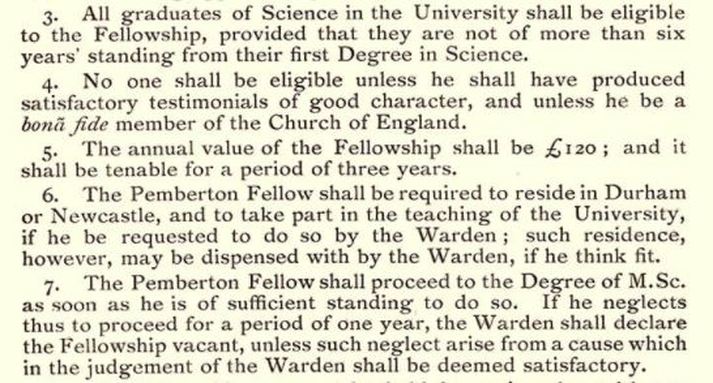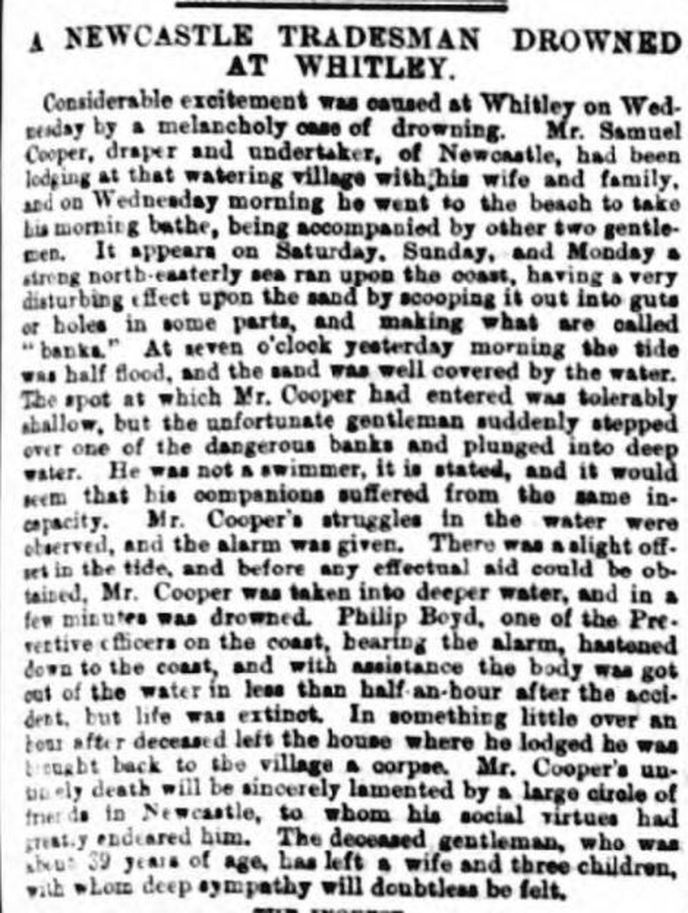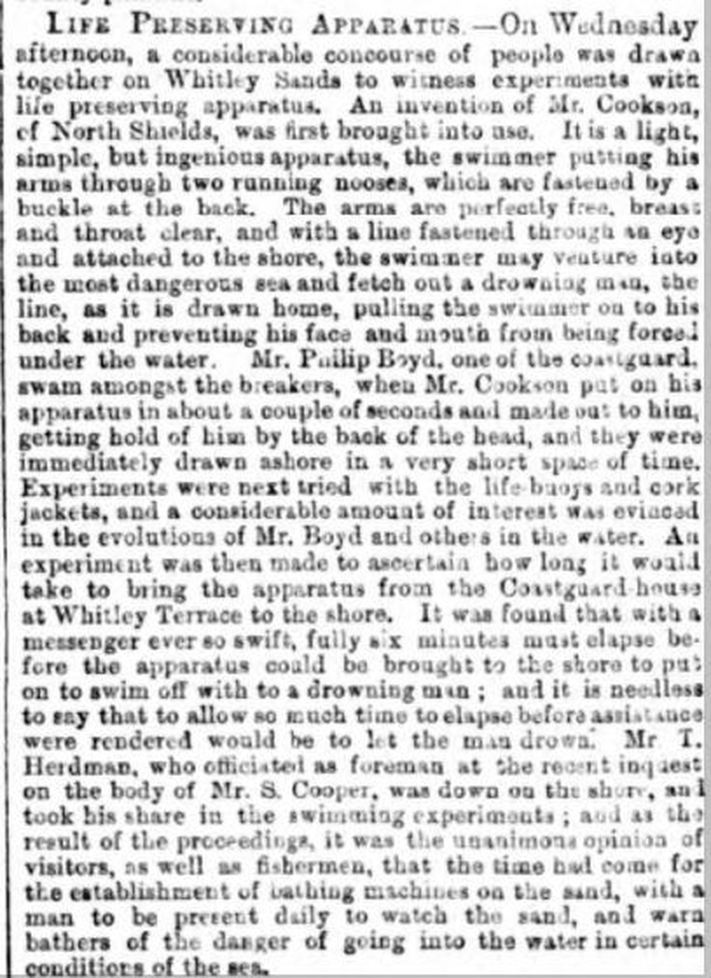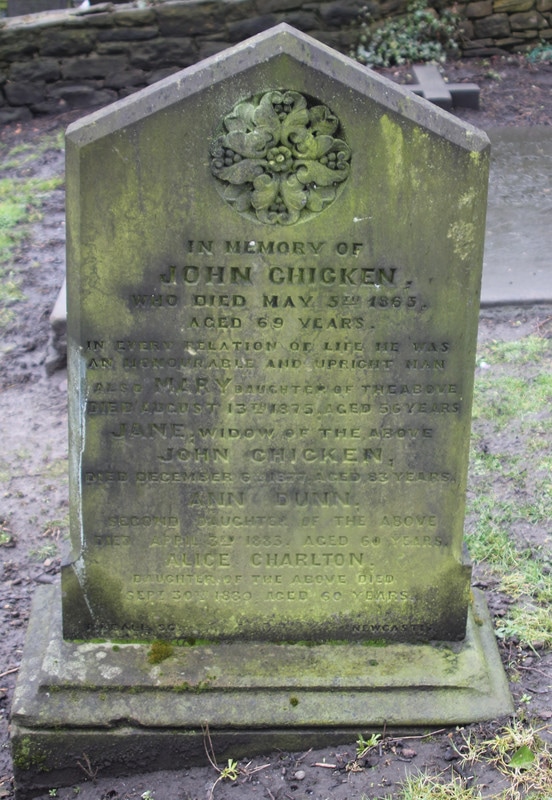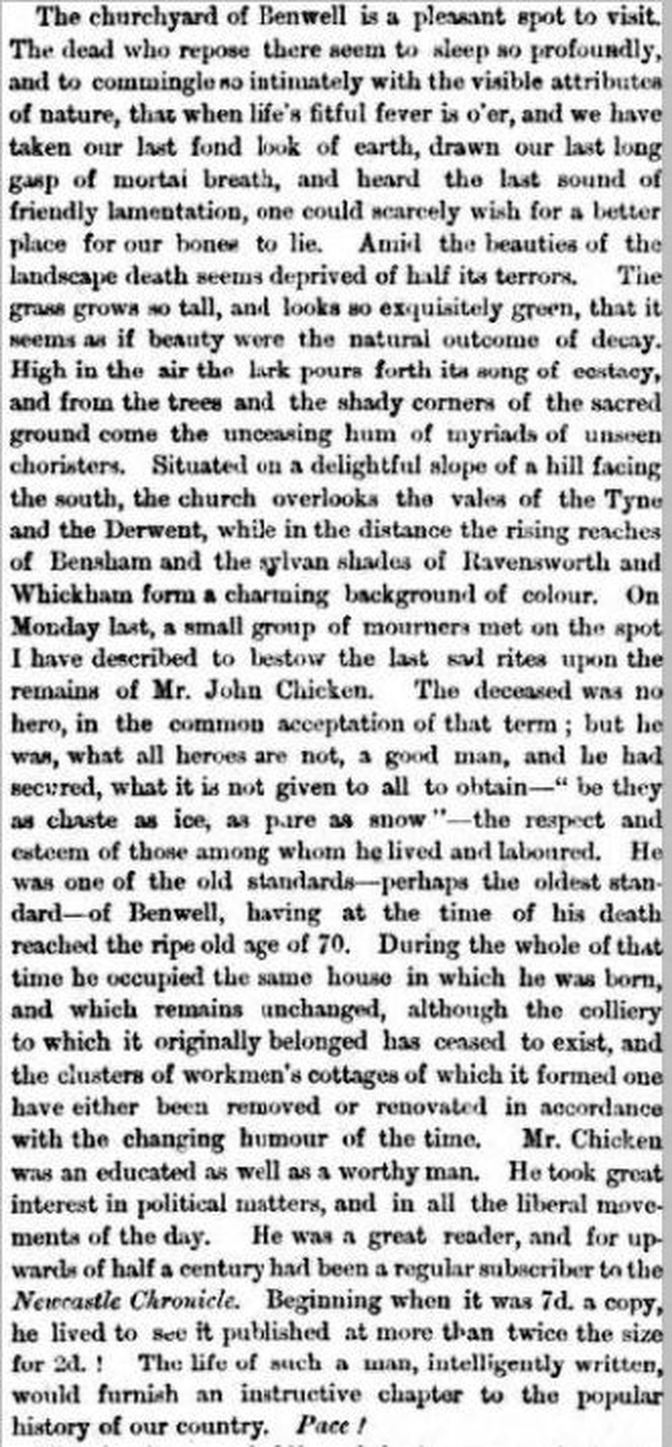|
'The life of such a man, intelligently written, would furnish an instructive chapter to the popular history of our country'. Unknown 1865. I love researching family histories that goes without saying, and every family has an interesting story to tell. It would also be true to say that some histories interest me far more than others, so when approached to research a family by the name of Chicken, thought to have originated in and around Tyneside in the late 18th early 19th centuries, this was a case I was not going to let pass. Whilst the surname Chicken may seem unusual, and indeed it is, there was quite a pocket of families by this name in the areas surrounding Newcastle at this time. Suffice it to say this family, despite the unusual name, presented the same obstacles encountered in similar projects covering the pre-statutory registration and census period. In these situations regional knowledge is key, and local historical community groups can be a vital source of information. To this end I must acknowledge the fantastic work currently being undertaken by the ‘St James’ Heritage & Environment Group’ in Benwell and thank them for providing evidence vital to this project. The point at which research for the project began was with William Chicken born in Newcastle upon Tyne circa the early 1820s. William had emigrated to Australia aboard the 'James Bains' with his Scottish wife Margaret Bartie and their young family in 1858. William was an ‘engine driver’ who died at the age of 57 in Wagga Wagga, Australia in 1878. The information provided on his death certificate proved the first and biggest obstacle of all, which has only very recently been conclusively resolved. His parents' names were given as John Chicken, also an ‘engine driver’, and Jane Robinson. No corresponding baptism record could be found to this parentage. The problem was exacerbated as William had left home before the first census in 1841, and therefore could not be traced through other household members. The process of tracing every William Chicken born in and around Tyneside at that time and eliminating them from the enquiry left just one parentage possibility. This was John Chicken, a colliery banksman in Benwell, and his wife Jane Moses. However, although almost certainly the correct couple, a small element of doubt remained. It was whilst investigating John Chicken that the story of an ordinary working class man in Industrial Tyneside began to emerge. Newcastle was built on coal, and the Industrial Revolution saw many men from very humble origins rise to prominence as the power of steam was harnessed and combined with advancements in engineering to drive industry and manufacturing. Contemporaries of John Chicken such as George Stephenson (1781-1848) ‘the father of the railways’ and his son Robert (1803-1859), did not have the benefit of a privileged education and wealth, but rather possessed a natural intelligence, aptitude and entrepreneurial spirit. William Armstrong (1778-1857), father of William George Armstrong (1810 -1900) who founded the iconic Elswick Works was also from a modest background. William junior rose to be an eminent scientist, inventor and philanthropist, who was knighted in 1859. These families would cross John Chicken's path through life in more ways than one. John Chicken was born on the 7th February 1795, the third of five children born to parents William Chicken, a colliery banksman, and his wife Alice Hogg of Low Benwell. Benwell was then a very different place to the Benwell we see today. It was largely a rural landscape of farms, open fields and market gardens with a few small privately owned coal mines. It was rapidly becoming a desirable and fashionable place for the wealthy to live. The ‘St James’ Heritage & Environment Group’ have produced a fabulous publication ‘Benwell through the years In Maps and Pictures’ which describes and illustrates the changes both industrial and urban, that took place throughout the 19th and 20th centuries. On the 3rd October 1818 John Chicken married Jane Moses at Newburn Parish Church where George Stephenson celebrated his own two marriages in 1802 and 1820. One of the witnesses to the Chicken nuptials is of particular interest as it provides evidence of interaction between the Chickens and the families of the rising industrialists. Rebecca Gilchrist Potter is believed to be the daughter of William Potter of Walbottle Hall, a part owner in the Walbottle Colliery where John was perhaps employed. Another daughter of William Potter by his first marriage, Anne, was married to William Armstrong and mother to the young future baronet. Rebecca married Thomas Wrightson on the 16th June 1834, and one of their sons, Thomas jnr, served his apprenticeship with his cousin, William G Armstrong, at the Armstrong Works in Elswick, before studying civil engineering at Westminster. His interest in 'mechanics' extended beyond the buildings of bridges, for which he would become best known, and circa 1920 'Sir Thomas Wrightson's Theory of Hearing' was published. The other witness to the marriage, Jonathon Moses, is believed to be either the father or brother of the bride but this is as yet unconfirmed. In all John Chicken and Jane would have six children, five of whom would survive into adulthood, with only the youngest Robert dying as an infant in 1833. The second child was William, the starting point for this research, whose baptism is entered in the Newburn parish register as the 15th April 1821. By the time the 1851 census was taken, John had left the mine and was working as a labourer in Armstrong's newly opened Elswick Works, by 1861 he had risen to the position of weighing machine clerk. He was living in Low Benwell at No. 33 Scotswood Road, just a short distance from ‘Paradise’, both of which are immortalised in the traditional folk song and Geordie Anthem, ‘The Blaydon Races’ written circa 1862. In 1851 two of John’s daughters, Ann and Alice, would marry, firstly Ann to Thomas Dunn an Ironmonger. In 1861 Ann and Thomas Dunn with their only son, John Thomas, were living at No 4, Saville Court, next door to her brother John an engine fitter, with his wife and daughter Mary. By 1871 the Dunn family had moved to 67 Grainger Street, and Thomas was now an auctioneer employing two men and 2 boys. In 1881 the family can be found living at 27 Oxford Street, Thomas snr was still an auctioneer but young John Thomas now aged 22, was recorded as an ‘analytical chemist’. In 1882 John Thomas Dunn was made a ‘Pemberton Fellow’ of Durham University. In April 1883 Ann died and Thomas followed soon after in July 1884. In October 1851 Ann’s sister Alice had married Samuel Cooper a ‘tailor and draper’. In 1861 the Cooper family were living at 12 Back Blandford St, with two of their three children Mary (1857) and Samuel T (1859). Their third child Earnest was born in late 1866, just as tragedy was about to strike. In July 1867, during a family trip to the coast at Whitley Bay, husband and father Samuel was drowned at sea whilst bathing. However, Samuel Cooper's death was not in vain, as later in July a newly invented ‘Life Preserving Apparatus’ was tested for the first time near the spot where he had perished. Although the trial was not wholly successful, it was unanimously decided that a bathing machine and lifeguard be immediately installed to prevent such accidents from happening in the future. The esteem in which Mr Cooper was revered by the community is evident from the accounts of his funeral, which was both large and well attended. His place did not remain vacant for long though as Alice, who was running the business which now included an undertakers, married a Mr George Charlton in 1870. George was a Master Tailor, former colleague of her husband and one of the mourners at his funeral. He survived his wife, who passed away on the 30th September 1889, and was re-married himself by the time of the 1891 census. The eldest sister Mary never married and died at the house she shared with her mother on the 13th August 1875. She and her sisters lie with their parents in the ‘old ground’ of St James’ Churchyard in Benwell. Their mother Jane Moses spent her last two years being cared for by daughter Alice and her second husband George Charlton, before she too was laid to rest on the 8th of December 1877 at the grand old age of 83. Of her husband John the inscription on the memorial ‘In every relation of life he was an honourable and upright man’ seems to echo the sentiments of the unknown writer of the following extract which appeared in the Newcastle Weekly Chronicle on Saturday the 13th May 1865. There are many words within this obituary that strike a chord. 'Mr Chicken was an educated man ...' may be a statement taken for granted today, but prior to the 'Education Act of 1870' (Forster's Act) there was no national system of education, and rates of illiteracy amongst the working classes were high. The Education Act of 1870 was the first to give all children the right to some form of education between the ages of 5 and 13. Both W G Armstrong and George Stephenson, who was himself illiterate until the age of 18, were great proponents of education for the working man. They were both incremental in the establishment of the Elswick Works school and Mechanics Institute, long before intervention by the Government, and to which Mr Chicken's literacy is more likely attributable. Other members of the family are also interred at St James’. Alice Chicken nee Hogg age 76 of Benwell Colliery, mother of John and grandmother to the girls, was buried on 13th July 1844. Robert, the infant son of John and Jane, was also buried here aged just 8 days on the 6th September 1833. Notable absences from the memorial and burial records are William and John, the couple's other two sons. William passed away in Wagga Wagga, Australia aged 57 on the 30th September 1878. John, by contrast, remained an engine fitter and mechanical engineer in Newcastle until his retirement. He died at No 9 Claremont Road in September 1902 and was survived by his wife, two daughters and several grandchildren. Descendants of William Chicken, who still live in Australia, will soon be visiting St James’ Benwell to pay their respects to their now confirmed 3 x great grandparents John Chicken, Jane Moses and their family. It is perhaps ironic but fitting that it was science that provided that last vital piece of evidence. It came in the form of a DNA match to a distant cousin, a descendant of Robert Chicken, brother of John Chicken senior, who moved to Liverpool and settled there sometime before 1820. This confirmation has opened the door to further research into the history of the Chicken family. Early indications are that before the move to Benwell they lived at Barlow Colliery near Blaydon. More ancestors may be amongst the many Chickens who lie buried in the ancient churchyard of Holy Cross in Ryton. Not far from Ryton, at Stella Haugh, is the site of the former ‘Blaydon Races’. It is as we would say up here, ‘just a kick in the pants away’. Useful Links St James' Heritage and Environmental Group stjameschurchnewcastle.wordpress.com/ Durham Records Online. https://www.durhamrecordsonline.com/ Durham Mining Museum http://www.dmm.org.uk/mindex.htm www.dmm.org.uk/mindex.htm Tyne & Wear Archives. Records of the Elswick Works School and Mechanics Institute. (Not online)
http://www.tyneandweararchives.org.uk/DServe2/dserve.exe?dsqIni=Dserve.ini&dsqApp=Archive&dsqCmd=NaviTree.tcl&dsqDb=Catalog&dsqItem=D.VA/74&dsqField=RefNo
3 Comments
Jane Slade
29/5/2017 05:58:38 pm
Really enjoyed this Susie - particularly as I was recently in Newcastle retracing the Nartin family roots - very pertinent now as I think Helen is likely to be singing Blaydin races when she performs I Newcastle city centre over Xmas in a panto extravaganza! Her Tyneside ancestors would be proud! I'll get her to read this article too ! Thanks
Reply
Jane Slade
29/5/2017 06:36:43 pm
Apologies for typing errors - my not accurate typing on I phone!! - 'Blaydon' and 'Martin' and 'in' !!!
Reply
Leave a Reply. |
AuthorSusie Douglas Archives
August 2022
Categories |
Copyright © 2013 Borders Ancestry
Borders Ancestry is registered with the Information Commissioner's Office No ZA226102 https://ico.org.uk. Read our Privacy Policy
